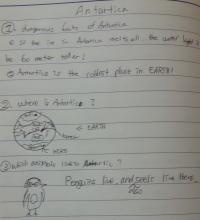안녕하세요! Cristi입니다. 저의 책임감을 위해 앞으로 제가 글을 올리기로 했어요.
이번 주제는 참 유익했던 것 같아요! 글쓰기를 할 때에 여행자 카페에 들어가 남극여행시 주의점같은 팁을 보았어요! 또 위키백과에 남극에 대한 참 많은 정보가 나와 있더라고요! 이번에 일찍 글을 올리는 이유는요~~바로 1등으로 올리고 싶었거든요!! (옆에서 엄마가 웃어요!) 이모들의 댓글은 저를 행복하게 합니다! 댓글 많이 달아주세요!
새해 복 많이 받으세요!![]()
Things I want to do at Antarctica
I want to touch the penguins because I am a penguin lover like Neil. Also, I want to go inside an ice cave. And I really want to see blue ice and pink water. I also want to see the Aurora too. I heard that fishing there was really fun, and I also want to go to Korea's research station.
Things we need to bring when going to Antarctica
Medical Supplies: Sun protection is essential. So we need to bring a good sun cream with high UV protection. The stick type of sun protection practical because you do not need to take off your gloves to put it on your face. You do not need a huge amount because it is only for your face. Finally, good sun glasses are extremely important. For the field (camping), we need a lot of baby wipes, as you cannot take showers.
Photo Equipment: You need a waterproof bag if you're going to take your camera and lenses ashore. Make sure you have plenty of batteries and a charger. Make sure you have plenty of memory.
Camping/Beach/Outdoor Gear: We need an eye shade to sleep with because it is always bright out as the sun never sets in the summer. Down (feather) booties are wonderful to wear in the tent and around camp.
Tip: Bring a towel. Bring books and a kindle for the field as you may get stuck in your tent for days by bad weather.
Clothing/Shoes/Weather Gear: You really need a pair of decent tennis shoes. Don't over pack. You'll need a waterproof jacket/parka and waterproof pants, something long that can go over the outside. You need good walking shoes. A full face mask is very useful in the field for wind protection.
About Antarctica
Antarctica is Earth's southernmost continent, containing the geographic South Pole. It is surrounded by the Southern Ocean. It is 14.0 million km2, and it is the fifth-largest continent in area after Asia, Africa, North America, and South America. For comparison, Antarctica is nearly twice the size of Australia. About 98% of Antarctica is covered by ice. Antarctica, on average, is the coldest, driest, and windiest continent, and has the highest average elevation of all the continents. Antarctica is considered a desert, with annual precipitation of only 200 mm (8 inches) along the coast and far less inland. The temperature in Antarctica has reached -89 °C. Human residents are not permanent, but anywhere from 1,000 to 5,000 people reside throughout the year at the research stations scattered across the continent. Only cold-adapted organisms survive, including many types of algae, bacteria, fungi, plants and certain animals, such as mites, nematodes, penguins, seals and moss piglets. The Antarctic Treaty was signed in 1959 by 12 countries; to date, 50 countries have signed the treaty. The treaty prohibits military activities and mineral mining, prohibits nuclear explosions and nuclear waste disposal, supports scientific research, and protects the continent's ecozone. Ongoing experiments are conducted by more than 4,000 scientists from many nations. The name Antarctica is the Romanized version of the Greek compound word meaning "opposite to the Arctic", "opposite of the north". The first formal use of the name "Antarctica" as a continental name in the 1890s is attributed to the Scottish Cartographer John George Bartholomew. Some of Antarctica has been warming up; particularly strong warming has been noted on the Antarctic Peninsula. A study by Eric Steig published in 2009 noted for the first time that the continent-wide average surface temperature trend of Antarctica is slightly positive at >0.05 °C (0.09 °F) per decade from 1957 to 2006. This study also noted that West Antarctica has warmed by more than 0.1 °C (0.2 °F) per decade in the last 50 years, and this warming is strongest in winter and spring. There is evidence from one study that Antarctica is warming as a result of human carbon dioxide emissions, but this remains ambiguous.


 쑥쑥몰
쑥쑥몰
 체험이벤트
체험이벤트








 초4- Cristi
초4- Cristi 











